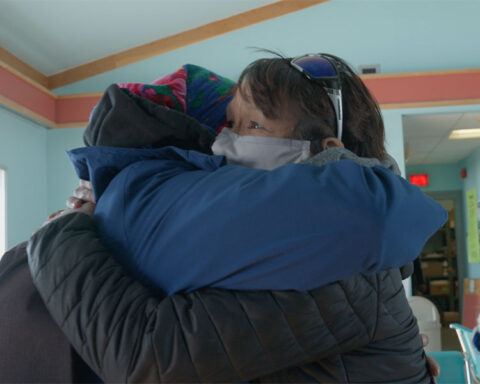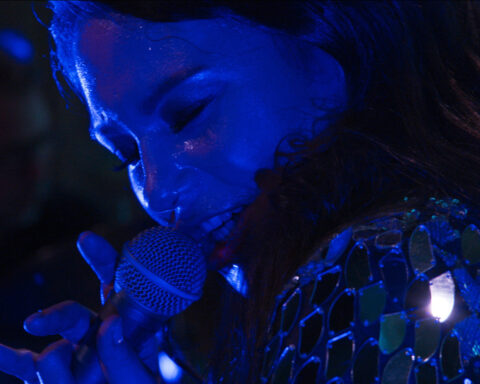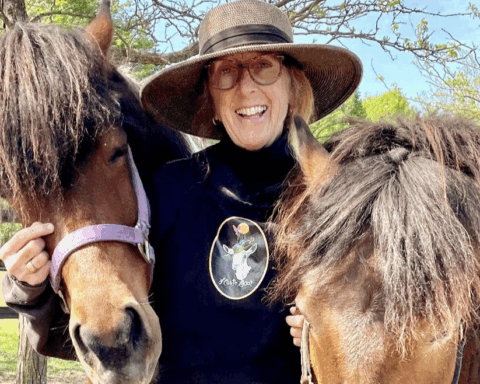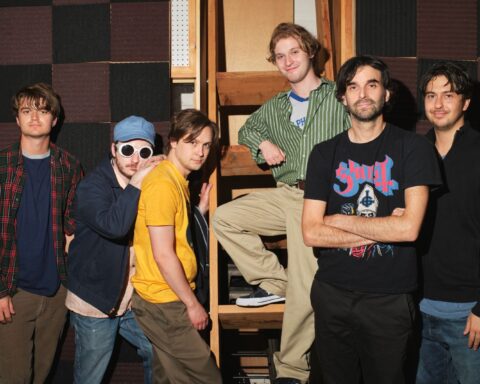Atanarjuat: The Fast Runner, the first- ever feature drama produced, written, directed, crewed and performed almost entirely by Inuit, won six Genie Awards, Best Canadian Film at the 2001 Toronto International Film Festival and the Caméra d’or at the 2001 Cannes Film Festival. That success focused international attention on Zacharias Kunuk, Atanarjuat’s director, and the company he co-founded, Igloolik Isuma Productions.
Established in 1989-90 by Kunuk, Paul Apak, Pauloosie Qulitalik and Norman Cohn, (its one non-Inuk owner), Isuma has been a nexus for community-based filmmaking: serving, preserving and enhancing Inuit culture as well as exporting it to new audiences for whom narratives about the North from a non- colonial perspective is a fresh, intriguing and eye-opening experience. The company has produced several documentaries, a television series (Nunavut: Our Land), video shorts in various genres and two feature dramas, the second of which, The Journals of Knud Rasmussen, had the honour of opening the 2006 Toronto International Film Festival.
Life out of balance
Zacharias Kunuk and Norman Cohn co-wrote and co-directed The Journals of Knud Rasmussen, which is set in 1922-23, when Christianity began replacing Shamanism in Inuit culture. As the title indicates, the screenplay adapts the journals of Danish-Inuit explorer and anthropologist Knud Rasmussen, who was then visiting the Arctic. Viewers might be confused by the title because Rasmussen, whose mother was Native and father a Dane, is only a minor character in the film and the perspective is firmly that of the Inuit family whose travails we are witnessing. But that, the filmmakers say, is exactly how Rasmussen’s account of his journey reads. Since he could speak the language and understand the Inuit’s dilemmas, Rasmussen recounted these events from their perspective and that, of course, provides fuel for the Isuma project. In fact, this is one of the few written documents that can be drawn on to provide such an aboriginal point of view, as, historically, Inuit culture was preserved exclusively through oral means.
The Journals of Knud Rasmussen is a complex web of storylines. As with Atanarjuat, lust plays a central role. A young wife, Apak, spurns her new husband. Instead she persists in having dream sex with the ghost of her murdered husband. Her father, the shaman Avva, struggles to make his wilful daughter accept tradition and her second husband. Meanwhile, the family is facing a severe shortage of food. There’s a group of newly converted Christian Inuit who do have food, but their charity comes at a price: renounce Inuit tradition and accept Christianity. Accompanying the family at various times are Rasmussen, trader Peter Freuchen, and anthropologist Therkel Mathiassen, who observe events much as the audience of the film will do, now.
This film, as is becoming emblematic of Isuma productions, portrays a historical moment when individuals and communities turn their backs on tradition, when outside forces interfere with the delicate balance of life in the North. These are difficult moments of transition, tense struggles between the forces of history, community, religion, personality and change.
Where no film has run before
Cohn and Kunuk are quick to point out that Isuma’s community-based filmmaking process is different from traditional filmmaking. They only reluctantly accept authorship of any Isuma film or video. Even more so than is usual in filmmaking, famously a collaborative medium, Isuma productions are works produced by an extended community. For Isuma, community involvement is integral to and inseparable from the creative process.
The creation of Atanarjuat, a supernatural epic of love, jealousy, revenge and Shamanism, exemplifies this. When screenwriter Paul Apak Angilirq thought of transforming this oral legend into a feature film, he first spoke with community elders, assembling and comparing the different versions and tellings. Throughout the writing process, he continued to consult with the community and even after a near-final draft was penned, elders carefully edited the dialogue to ensure that characters spoke in authentic sixteenth-century Inuktitut, free of infiltration by Southern colonial languages. The costumes were then designed and sewn by members of the community. Finally, the film was shot on location, not on simulated sets. At every stage, save for some post- production work in Isuma’s Montreal office, the production employed Inuit people working in their own environment.
Atanarjuat: The Fast Runner and The Journals of Knud Rassmussen typify the new genre that is being fashioned by Isuma: not quite docudrama, not quite fiction, not quite documentary, but a new hybrid of video filmmaking and traditional Inuit oral storytelling. Prior to Atanarjuat, Kunuk and Isuma began developing this new genre in three video dramas, Qaggiq: Gathering Place (1989), Nunaqpa: Going Inland (1991), and Saputi: Fish Traps (1993) and the 13-part television series Nunavut: Our Land (1994-95). All of the works in this new dramatic genre are performed in Inuktitut with, of course, subtitles for non-Inuit audiences.
Not all of Isuma’s films mine this vein. The company also produces more conventional documentaries on the contemporary Inuit experience, such as Urban Inuk, directed by Jobie Weetaluktuk, concerned with the plight of Inuit in urban settings such as Montreal, and Kiviaq versus Canada, Kunuk’s latest project, which describes the struggle of an Inuk lawyer suing the Canadian government.
The only Inuk ever to be an Eskimo
Kiviaq’s story is the stuff of legend. In 1939, Kiviaq, one of his sisters and his mother were taken away from their home in the North—leaving behind four other siblings—by a white RCMP officer and brought to his home in Edmonton. The officer married Kiviaq’s mother and adopted the children, renaming the three- year-old boy David Charles Ward. The boy and his Inuit family were forbidden to speak Inuktitut or to refer to their non- white origins. Nevertheless, the boy was repeatedly beaten up by other kids for being “a flea-bitten Eskimo”—until he learned how to fight. The teenager trained at a local boxing club and eventually became a Golden Gloves champion, winning 108 out of 112 matches. Soon after the boy’s fighting skills blossomed, his stepfather stopped laying hands on him.
After retiring from the ring, Kiviaq briefly played for the Edmonton Eskimos, thus becoming the only Inuk ever to be an Eskimo.
In the late 1960s, David Charles Ward, as Kiviaq was still called then, was elected to Edmonton city council, a position he kept throughout the 1970s. After an unsuccessful bid for mayor, he quit politics to host a radio show. Shortly thereafter, he went to law school and in 1983 earned his degree, becoming the first Inuk lawyer.
It was around this time that the seeds for his later struggles were sown. Kiviaq had discovered, on entering law school, that, unlike other aboriginal Canadians, he did not have access to free higher education. Digging deeper, he found that the rights afforded to the aboriginal peoples of Southern Canada did not apply to the Inuit. In his view, the Inuit—who, unlike other aboriginals, pay taxes—are not accorded the privileges of other tax- paying Canadians, but neither do they benefit from the privileges associated with aboriginal status. Politically and economically, the Inuit are still under patronizing colonial rule, and Kiviaq, who legally reclaimed his Inuit name in 2001, wants that to change.
However, neither the federal government nor Nunavut authorities are very keen on the idea, citing, among other things, land-claim treaties that supposedly invalidate Kiviaq’s suit. Undaunted, Kiviaq fights on.
Kunuk first learned of Kiviaq’s story by reading an article in an airline magazine. The Inuk lawyer’s struggle excited the director’s imagination and resonated with some of his own experience. Kunuk contacted Kiviaq and, with the help of producer and co-writer Katarina Soukup (another of the handful of non-Inuit working at Isuma), began fashioning the documentary. Kiviaq versus Canada premiered at the Edmonton International Film Festival in September 2006 and is scheduled to air on the History Channel in late 2006.
In the documentary, Kunuk visits Kiviaq in his Edmonton home, and slowly his rich, eventful life unfolds. The charismatic Kiviaq holds the camera’s attention with a combination of graceful good cheer and emotional intensity. The more he reveals about his lawsuit, the more hopeless it appears; yet, David-like, he is unwilling to give up against the Goliath forces of the Canadian government.
The film culminates in a Michael Moore moment: after countless fruitless attempts to get an official statement from Indian and Northern Affairs Canada, the camera-wielding filmmakers descend on the ministry’s Ottawa offices, with, alas, the same frustrating results the American maverick gets whenever he orchestrates such stunts: tense interactions with panicked security personnel; brief, awkward exchanges with clueless jargon- spouting media spokespersons; no encounters with any significant players; and no tangible results.
Cowboys and Inuit
Director Zacharias Kunuk, born in 1957 at Kapuivik on the Arctic tundra, may not have been taken from his community in as radical a way as was Kiviaq, but the lawyer’s story resonates with his own experience. In 1965, when Kunuk was nine years old, the Canadian government pressured his family to abandon their nomadic lifestyle and settle in the then-new town of Igloolik on Baffin Island. Government employees threatened to take away the family’s allowance unless their children were sent to school. Up until that time, the filmmaker-to-be had been fully expecting and prepared to follow in his father’s footsteps and live the traditional nomadic life of an Inuit hunter.
Looking at Kunuk’s body of work, it’s tempting to cite the move to Igloolik as the defining moment of his creative imagination. Much of his work — most explicitly Nunavut: Our Land, Kiviaq versus Canada, The Journals of Knud Rasmussen —deals with moments of cultural transition, with clashes that confuse identities, transform traditions and provoke self-questioning. Even Atanarjuat, which doesn’t involve non- Inuit cultures, covers some of the same territory. In that case, the central questions became: what happens to the community when someone defies tradition? Can a culture survive such a sundering?
It’s in Igloolik that the young Kunuk first developed a passion for movies. He remembers most vividly seeing John Wayne films at the Igloolik community hall and being shocked at the violent ways of Indians in those films. Watching those cowboy spectacles, he learned to see through white eyes. Later, he reconnected with his own identity and began to see himself as an Inuit person and filmmaker. During this process, he learned that there are a number of ways to tell the same story and several perspectives from which to tell it. The story of the North from the Inuit perspective is, for example, different from the tale told by Christian missionaries or the Canadian government about the same time and place.
Carving a niche
The young Kunuk paid for his filmgoing habit by taking up soapstone carving. By 1981, when he’d already established a reputation as carver, Kunuk sold three sculptures in Montreal and used that money to buy a video camera. He took it with him back to Igloolik. At the time, by choice, the community still didn’t even have television.
In the 1970s, Igloolik voted twice against allowing television, mainly because there was no content in Inuktitut. The creation of the Inuit Broadcasting Corporation (IBC), with its aboriginal programming, transformed the media landscape of the Arctic.
From 1982 to 1990, Kunuk worked for the IBC as senior producer and station manager, but the institution’s narrow view of acceptable content constantly frustrated him. In 1985, he received a Canada Council grant to make his first independent video, From Inuk Point of View.
His crew? None other than Paul Apak (editor), Pauloosie Qulitalik (cultural narrator), and Norman Cohn (camera). Together, within a few years, these four would form Igloolik Isuma Productions, a video collective dedicated to keeping Inuit culture alive. Three of Isuma’s founders were Inuit, but what was Norman Cohn, an American expat living in the Province of Québec, doing among that group?
Familiar in a strange land
In the early 1980s, a friend handed Norman Cohn, already established as a video artist, an early piece by Zacharias Kunuk. Cohn was struck by the aesthetic kinship between Kunuk’s work and his own. To Cohn, it was as if Kunuk had shot his video with Cohn’s eyes. Cohn travelled to the Arctic to meet with Kunuk, and the two quickly developed a strong and lasting friendship. Later in the 1980s, far from any settlement, stuck in the middle of a rainstorm in a tent with the rest of the quartet that would later come to form Isuma, Cohn realised that, more than anything, he wanted to make films with these people.
One particular event is still vivid for him. Someone in the group realized that their boat was being blown away by the storm. So the three Inuit, rushed out barefoot in the freezing water after the boat while Cohn shivered, convinced that he would die there. The trio came back, mission accomplished, laughing about it all. That unshakeable good humour in the face of the most perilous adversity utterly seduced him, and thus his future was settled.
Cohn lived for several years in the Arctic, but he moved back to the Montreal area when Isuma’s growing success outside of its home community dictated that a Southern office was needed for postproduction and promotional work.
To think
Although Kunuk, whose accolades include becoming an Officer of the Order of Canada and being named the Globe and Mail’s Man of the Year in the Arts in 2002, is the company’s star director, Isuma has produced work by other filmmakers. Not all the documentaries are by him. The company is responsible for a catalogue of short independent videos by various Inuit filmmakers and feature films by other directors are in the works.
Currently in production is Before Tomorrow, set in 1840, directed by Marie Hélène Cousineau and Madeline Ivalu. This film, adapted from the novel For morgendagen by Danish writer Jørn Riel, is the culmination of fifteen years of cooperation between Isuma and Arnait Video Productions, a group that, since 1991, has been collecting the stories of Inuit women. Isuma works closely with other Inuit community groups as well. According to Kunuk and Cohn, it’s likely that other feature films will soon emerge from such cooperative relationships.
“Isuma” means “to think.” Certainly the body of work emerging from the creative community surrounding Igloolik Isuma Productions is encouraging the whole world to think in new ways about life in Northern Canada.











